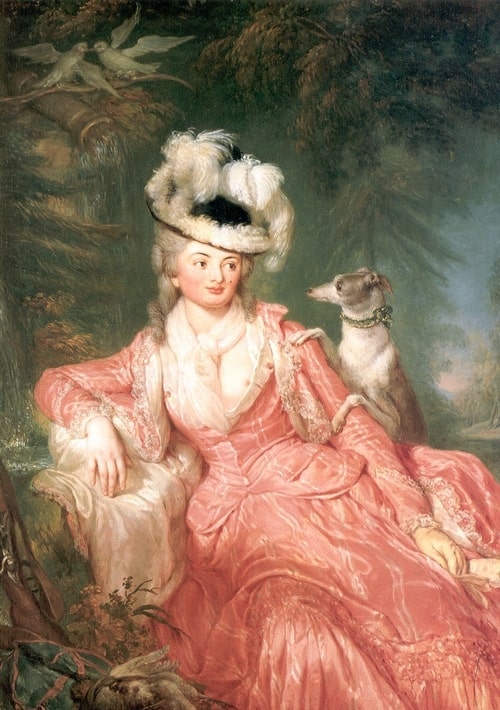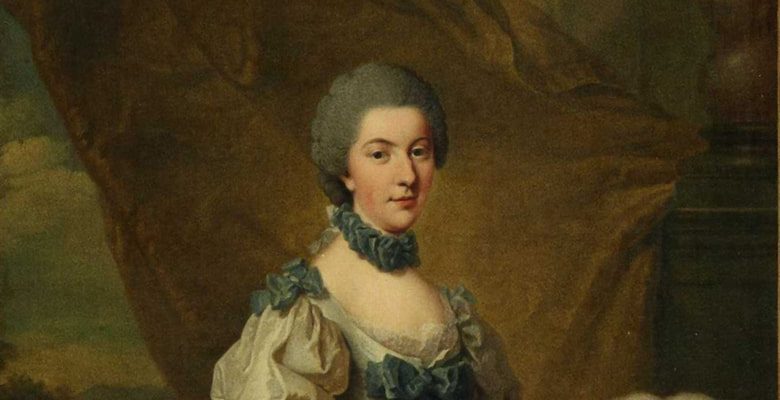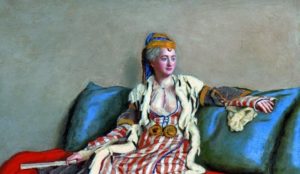Elisabeth Christine Ulrike of Brunswick-Wolfenbüttel was briefly a Crown Princess of Prussia as the first wife of Crown Prince Frederick William, until her rebellion and refusal to play along with their double-standards got her exiled for life.

An Unhappy Early Life
Elisabeth Christine Ulrike was born in 1746 as the tenth child of Carl I and Duchess Philippine Charlotte of Braunschweig-Wolfenbüttel.
Elisabeth was the third daughter born to the couple, and one of her sisters was Anna Amalia, later Duchess of Weimar and friend and supporter of Goethe. The girls’ childhood wasn’t a happy one. Their mother was highly educated, active both as a patron of the arts and as a composer of music, but apparently was a strict parent who showed little love to her children.
Like her older sister, Elisabeth was married off to the partner deemed to be most advantageous by her relations. In her sister Anna Amalia’s case, that marriage was eventually to bring her considerable power and independence following her husband’s early death.
But the consequences of Elisabeth’s marriage led her down an entirely different path, to a life she could never have imagined.
A Doomed Marriage
At a young age, Elisabeth was selected as a bride for her first cousin and heir to the Prussian king, Friedrich Wilhelm.
A wife was urgently needed, in the King’s view, to bring his party-boy nephew back on to the straight and narrow. Whilst Friedrich Wilhelm’s attention was absorbed with the sober disciplines of warfare, music and philosophy, the Crown Prince was well-known for being partial to, ahem, pleasures of a more sensual nature, and was not shaping up to be good future king of Prussia in his uncle’s eyes.
The couple were married in July 1765 and subsequently moved into their new living quarters in Potsdam.

But it soon became apparent that the Crown Prince had no intention of changing his wanton ways now that he was a married man.
Just a few doors down from the royal couple’s new home lived one of the king’s musicians, along with his daughter Wilhelmine who, although just 13 years old, had already attracted the Prince’s attention. He resolved that she should receive a proper education and should subsequently become his mistress, and now, following his nuptials, he simply continued with his “project”. However, this came to the King’s knowledge and the Crown Prince was obliged to have Wilhelmine sent away to Paris. She was out of the picture, but only temporarily – their relationship continued for many years and she would go on to have six children by him.
Of course, Elisabeth was soon aware of these shenanigans – and presumably this wouldn’t have bothered her husband in the slightest. He saw no reason to keep his continual affairs and dalliances secret from her, apparently even praising the charms of various other women to her face. After all, a wife was there to produce legitimate heirs – beyond that she should simply be obedient and submissive.
But unfortunately for him, these were not words that described Elisabeth Christine Ulrike.
She was a vivacious, proud and strong-willed woman, who wasn’t going to stand by and let her husband humiliate her. She found ways to enjoy herself and preserve her self-respect: she would frequently visit her aunt Elisabeth, the Queen, at her palace in the north of Berlin, and insisted on making these visits on horseback, riding astride like a man. This raised eyebrows, as it was believed not to be conducive to pregnancy.
Exile from the Court
However, in 1776 came the surprising news that Elisabeth was indeed pregnant. As far as the court was concerned, this had not been on the cards: her husband was currently far more occupied with a beautiful countess than with his wife.
Unfortunately for Elisabeth though, she gave birth to a daughter, and not the hoped-for male heir.
King Friedrich was disappointed but hoped that further pregnancies would now follow; however, Elisabeth still did not appear willing to play her assigned part of dutiful wife and bearer of children.
She continued to enjoy herself, dancing and horse riding, and there were now rumors that she had lovers. After being humiliated by her husband’s constant infidelities, she was getting her revenge, and of course, Friedrich Wilhelm was not happy at all; however, the King was reluctant to agree to a divorce, knowing how much this would hurt his sister Philippine Charlotte. He also had some sympathy for his niece and could see how she had been driven to her indiscretions by his nephew’s behavior.
But ultimately, where such conduct could be overlooked or excused in a prince, it simply could not be tolerated in a princess.

Princess Frederica Charlotte of Prussia
And when the scandalous revelation came that Elisabeth was planning to flee to Italy with her lover, a musician named Pietro, the King had no choice but to consent to a divorce, whilst poor old Pietro was arrested and reportedly later executed.
The royal marriage was annulled in April 1769. Just two days later, Elisabeth learned that her punishment would be life-long banishment, and that she would be escorted to the town of Stettin (then part of Prussia but now in Poland) that very evening.
The news apparently came as a shock to her and she was upset – understandably so: she was to be separated forever from the people she loved and all that was familiar to her. She was never to see her daughter again, or the rest of her family, not that most of them wanted anything more to do with her: on the next occasion that her mother Philippine Charlotte saw King Friedrich, she is said to have told him that she “cursed the day when she brought such an abhorrent daughter into the world”.
Upon arrival in Stettin, she was taken to the castle there that had long stood empty, where she was assigned a suite of rooms and provided with two ladies in waiting. Thus her new life began.
Elisabeth’s New Life in Exile
To begin with, she was under close surveillance, and was permitted to leave her rooms only to cross the gangway to the chapel.
However, she shouldn’t be pictured as languishing in some sort of bare cell-like quarters with only bread and water to survive on. Records show, for example, that there was not enough satin available in Stettin for Elisabeth to cover her chairs with, which I think qualifies as a first-world problem. Even a disgraced princess is still a princess, and it wouldn’t be fitting to deprive her of satin covered chairs. She was also provided with various staff including a secretary, an accountant and a cook.

Princess Friederike of Hesse-Darmstadt
As time went on, she gradually acquired more freedom: she was permitted to go out walking, which she did dressed in practical clothes with shorter skirts than were the fashion; a style that local women apparently tried to copy, with less than elegant results. She became a popular figure in Stettin society and was invited to the homes of the local nobility. She was also a keen needlewoman, had a passion for music and was devoted to her pet dogs.
Her former husband, meanwhile, had remarried soon after he divorced Elisabeth. His new wife, Friederike of Hessen-Darmstadt, seems to have been everything that Elisabeth was not. Quiet, sensible and docile, and not regarded as attractive or talented, she dutifully bore Friedrich Wilhelm eight children, whilst he continued his relationship with Wilhelmine.
Later after he became king of Prussia, and with his wife still very much alive, he married not one, but two of her ladies in waiting. Poor Friederike was obliged to consent to these marriages, but at least she had the nouse to do so only on the condition that her husband paid off her substantial debts.
The years passed; the old century ended and a new one began. By now, Elisabeth no longer felt like a captive. In 1806, Princess Luise Radziwill passed through Stettin on her flight from Napoleonic troops and paid Elisabeth a visit. She reported that Elisabeth, now 60 years of age, retained the liveliness and impulsive nature of her youth, and spoke with remarkable jollity about the events that had originally brought her to Stettin.
Elisabeth Christine’s Legacy
As you can imagine, she was a legendary figure even within her own lifetime, and there were various stories told about her. She was said to have had all of her furniture upholstered in blue and yellow fabric, the colours of the house of Braunschweig (a way of asserting her identity and distancing herself from the Prussians who had brought such misfortune upon her). She was an enthusiastic knitter, and her servants were obliged to join her in this occupation, producing innumerable items in blue and yellow wool.
On the other hand, she quipped that she didn’t want to be laid to rest next to the “the old guys in Braunschweig”, hence her decision to have a large mausoleum built for herself in the castle grounds.
She is also said to have taken a mischievous pleasure in embarrassing people in her old age: according to one anecdote, a chaplain had come to her house to celebrate Holy Communion with her and thus aid her spiritual salvation. But her favourite dog was sitting on the chair next to her, and since she refused to move it despite the chaplain’s request, the service could not take place.
She is supposed to have been kind to children, giving them treats when they came to visit her. On one occasion, she apparently procured a huge quantity of salt (an expensive commodity at the time), creating a white hill for the local children to sled down in the middle of summer.
Elisabeth Christine Ulrike died in 1840 at the grand old age of 93, meaning that she had spent a whopping 70 years in exile. Her funeral was attended by the great and the good of Stettin, and all the bells in the city rung out to mark the end of the long and remarkable life of the former Crown Princess of Prussia, who had later come to be known simply as “Lisbeth of Stettin”.
Sources:
Lecture at the Institut für Braunschweigische Regionalgeschichte by Gerd Biegel, plus some additional information that he kindly provided me with
Frauen der Welfen, Elisabeth Kwan et al, 2011
Originally from the UK, I have lived in Germany for over ten years, working as a translator. I have a passion for pre-20th century German history and have been writing the blog Braunschweig Portraits, featuring notable historical figures from the town where I live, for the past few years.







“On one occasion, she apparently procured a huge quantity of salt (an expensive commodity at the time), creating a white hill for the local children to sled down in the middle of summer.”
Thank you ever so much. I didn’t know about this tidbit, which, however, gives a lot of background to a novella I love. I suppose you’ve never read “Schach von Wuthenow”, by Theodor Fontane (who was, in my estimation, the most Prussian of all Prussian authors)? Written around 1880, the story takes place in in the year 1806, and a part of it describes a sledge party arranged by high ranking officers of the Prussian army, at Berlin, in the summer of that year 1806. To accomplish this, they had several streets of the capital covered with a thick layer of salt. I’ve always wondered how Fontane, who seems to have been a rather unimaginative person, came to invent such an outlandish thing. Now I know.
(BTW, if you should chance to look up Wikipedia for the novella in question — please do not believe their interpretation of the text. It’s utter nonsense.)
And please forgive me for pointing out two things in your post which seem questionable to me:
“Whilst Friedrich Wilhelm’s attention was absorbed with the sober disciplines of warfare, music and philosophy, the Crown Prince was well-known…”
seems to imply that you mixed up the names of the king and his successor. A few paragraphs later, you give the name of the king correctly as Frederick (Friedrich), so, again, please forgive me for pointing it out.
“holy communion”
Well, I have my doubts about that. It’s such a catholic term. However, the Prussians and Brunswicks were staunch protestants (Lutheran, or Calvinist in the case of king Frederick’s father), and one would rather expect them to use the expression “the Lord’s Supper”” (= “Abendmahl”, in German).
Once again, thank you, and please forgive my nitpicking.
Wow, thank you so much for responding to my article! I’m so pleased to know someone has actually read it! You are completely right about the mistake with Friedrich Wilhelm, well-spotted, I will see if I can get that changed. There were so many Friedrichs and Wilhelms and Friedrich Wilhelms that it is easy to get muddled (and I am just an enthusiastic amateur historian). Thanks for pointing out that holy communion isn’t the correct term – that was probably an error of translation on my part reflecting an insufficient knowledge of confessional differences. The anecdote about the salt was from the lecture given by Prof. Biegel if I remember rightly, an eminent historian of Braunschweig. It is a charmingly bizarre detail and it does sound like it may have inspired Fontane! I do not know that particular book although I have read several other Fontane novels. I will seek it out. Thanks again for your detailed comments.
Wow, thank you so much for responding to my article and I’m sorry I never saw this! I’m so pleased to know someone has actually read it. You are completely right about the mistake with Friedrich Wilhelm, well-spotted, I will see if I can get that changed. There were so many Friedrichs and Wilhelms and Friedrich Wilhelms that it is easy to get muddled (and I am just an enthusiastic amateur historian). Thanks for pointing out that holy communion isn’t the correct term – that was probably an error of translation on my part reflecting an insufficient knowledge of confessional differences. The anecdote about the salt was from the lecture given by Prof. Biegel if I remember rightly, an eminent historian of Braunschweig. It is a charmingly bizarre detail and it does sound like it may have inspired Fontane! I do not know that particular book although I have read several other Fontane novels. I will seek it out. Thanks again for your detailed feedback.